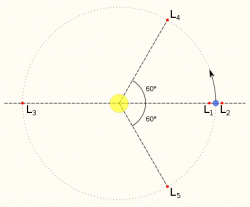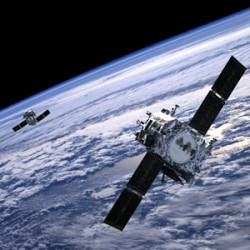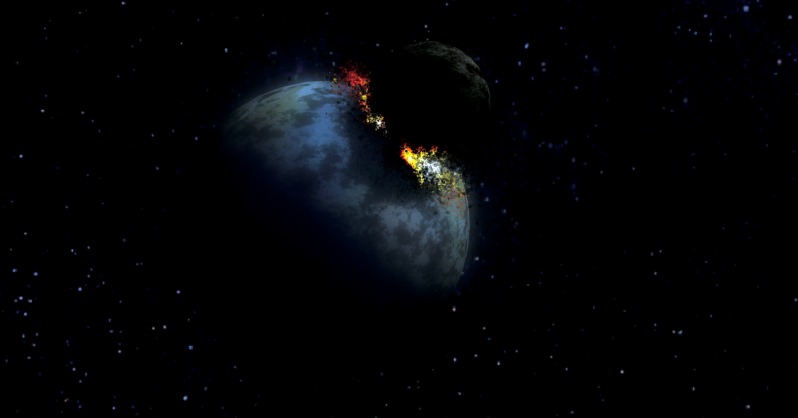[/caption]
Two solar telescopes launched to study coronal mass ejections and the solar wind have been sent to do an entirely different task. Currently, the Solar Terrestrial Relations Observatory (STEREO) probes are flying in opposite directions; one directly in front of Earth’s orbit and the other directly behind. This unique observatory is intended to view the solar-terrestrial environment in unprecedented detail, allowing us to see the Sun from two vantage points.
This might sound like an exciting mission; after all, how many space-based observatories have such a unique perspective on the Solar System from 1 AU? However, both STEREO probes are currently moving further away from the Earth (in opposite directions), approaching a gravitational no-man’s land. STEREO is about to enter the Earth-Sun Lagrangian points L4 and L5 to hunt for some sinister lumps of rock…

The L2 point is located at approximately the same distance, but on the opposite side of the Earth. In this case, the Earth is constantly eclipsing the Sun. The L3 point is on the opposite side of the Sun from the Earth, at approximately 1AU. Now this is where it starts to get a little strange. The L4 and L5 points are located 60° in front and 60° behind the Earth’s orbit. The 4th and 5th Lagrangian points are also the most gravitationally stable regions, primordial debris lurks, trapped in the Lagrangian prisons. Although the L1 point is often considered to be the most stable of the Lagrangian points (as it’s directly locked between the gravity of the Sun and Earth), even space observatories (such as SOHO and ACE) have to carry out complex orbits to remain in place. Otherwise the delicate balance will be lost and they will drop away from L1.
L4 and L5 are in fact the most stable locations, balanced by a complex cage of competing gravitational components from the Earth and the Sun. It is thought that these two regions have trapped lumps of rock and dust all the way through the evolution of the Solar System, making them a very interesting place to send a space mission. And the two solar probes of STEREO are currently racing toward L4 and L5, about to explore the gravitational dead zone, whether they like it or not.
It is a known fact that other planets in the Solar System possess these islands of gravitational calm, and asteroids have been observed sitting in stable locations in front and behind of Jupiter’s orbit for example (called “Trojans” and “Greeks”). Does Earth have a swarm of asteroids sitting in its L4 and L5 points? Scientists believe this is a certainty. However, no asteroids have ever been observed.
Although millions of kilometres across, L4 and L5 can only be observed at dawn and dusk. Any possibility of spotting a large asteroid diminishes rapidly as they are obscured by the Sun. So, the STEREO space telescopes are going to take the dive into L4 and L5 to see, first hand, what lies in wait.

Although STEREO wasn’t designed for this work, the mission already has a team of volunteer near-Earth asteroid hunters at the ready and their optics are more than capable of looking out for large lumps of rock invisible from Earth.
“The close-up investigation of L4 and L5 is completely new. That makes it something we should be driving,” says Richard Harrison of the Rutherford Appleton Laboratory in Oxfordshire, UK and a member of the STEREO project. “Wouldn’t it be spectacular if we actually backed past an asteroid? Saw it come creeping into view around the camera.” Now that would be a huge discovery.
This isn’t simply out of academic curiosity however. The Earth’s Moon is thought to have been formed after a huge cosmic impact with a small planetary body. The problem comes when trying to explain where the offending planetary body could have come from; too far away and it will have had too much energy. Rather than punching into the side of the Earth it would have shattered our planet. So the body must have formed a lot closer to our planet.
Did this body evolve in either the L4 and L5 points? If it did, and then somehow got kicked out of the gravitational island, perhaps careering toward the Earth, causing the cataclysmic impact that seeded the formation of the Moon.
It is exciting to think that STEREO may make some ground-breaking discoveries not Sun related. I just hope they don’t bump in to any chunks of rock, it could be pretty crowded out there…
Source: New Scientist


I predict there is nothing there.
The biggest problem is not that asteroidal objects cannot exist there, but in fact how they got there in the first case!
Clearly perturbations killed any the objects here years ago.
Interesting read, but sorry, unlikely.
I predict they will find remains of on old earth orbiting space stations the dinosaurs built 65 million years ago, these huge stations could divert asteroids from hitting the Earth and park them in L4 and L5, unfortunately rouge t-rex’s taught it funny to smash the Earth with an asteroid which lead to their species demise.
Now the technology will be ours. 🙂
The claim of dinosaur-built space stations is outrageous. These space stations were more likely built by the puppy test pilots the Russians launched in the early days of the space race.
My God, Russian Puppies, we are indeed doomed, the predictions for 2012 are true.
L4 and L5 are precisely where one will find the tips of His Noodledly Appendage while He sits in His Splendor at L3 waiting patiently for 2012, The Time Of Ripening, when He will perform a reach-around of awesome proportion and harvest the TWWFG (Those Who Worship False Gods).
Edit: Not to say that the article is good. It is informative, just misleading, and doing nothing to ease the hysterical “omg asteroids & comits r everywhere and r goin to kill us on 2012” sort of mindset.
isn’t good* And i need to proofread, too.
I think that the 2012 people put some money together and lauched some asteroid out there. Just in case the real planet X does not arrive, this way they have at method to safe their face. LOL
I have some marinara sauce for His Noodleness.
A bit sensationalist for my taste and I’m not even a scientist.
It’s sensationalist to theorize that something might be sitting in a gravitational dead zone because the dead zone itself imparts no kinetic energy to it?
Yeah. That’s a HUUUUUUUUGE leap.
I don’t know, I’m sitting in a pain in a corner watching at the first pic.
Also, your first sentence doesn’t work. If it’s a question, then it should have started with IS IT.
Peace. 🙂
Rouge T-reges? They must be worse than pink puppies, yes.
Come on people, we all know what were going to find there. Anyone who has ever read Arthur C. Clarke knows that the trojan L points are populated by eyes; The Firstborn artifacts exactly one meter across perfectly spherical and perfectly reflective. Come on.
Well, in the case of Jupiter, there are indeed objects out there at L4 and L5, they are called the Trojans I think.
I recall reading about deep, ground based photographic searches of several of the Lagrangian points (including L4 & L5) in the late 1950’s & 1960’s. No bodies were detected in any of these surveys down to magnitudes of about 16 or 17. Still, clouds of tinier objects could still lurk undetected at these locations, hence the need for observations like those planned for the STEREO spacecraft. It should prove interesting whether they find anything at these locations.
Salacious,
Two asteroids, neither with the right velocity to stay in L4 or L5, nonetheless collide in L4 or L5. Some of the collision products do have the right velocity, and they stay. And the method I’ve outlined is not the only one either. Two objects could interact in a non-collisional manner via gravity (and one of these objects could be a planet – your “perturbations” working in reverse). Or the Yarkovsky effect could move an object there. Or an object with a high rate of rotation (perhaps spun up by the YORP effect) could burst, and some of the fragments would happen to have the right velocity to stay.
Thus there is a handful of methods of repopulating these areas should perturbations clean them out, rendering your suggestion that nothing is there improbable. Your biggest clue that you were wrong, though, should have been the Jupiter Trojans.
T-reges: dreadlocked archosaurs jammin’ on ganja. 😉
Duct tape . . . now *there’s* a thought. If paleontologists ever discover duct tape in the strata they dig out — some grad student will get bawled out for pulling pranks and/or losing his stuff at the dig. 😉
So if we find a bunch of asteroids at L4 and L5, then does that mean we no longer live on a planet? After all, the IAU says that a planet must clear its orbit. I suppose Trojan asteroids must be an exception.
Either way, I think, will be a positive. If there are indeed asteroids, they will be relatively stable and easy to reach for study and/or mining, hollowing out, moving to LEO, etc.
If there are none, then we have some clear and stable points at 1 AU which we can use for all sorts of things – though L3 is the obvious choice from which to launch attacks for Operation Evil Overlords…
I must say that I completely discount the Dinosaur Space Station Theory. No one has ever found any evidence that the dinosaurs invented velcro, duct tape, or WD-40. Without those materials, space flight is impossible.
“Currently, the Solar Terrestrial Relations Observatory (STEREO) probes are flying in opposite directions;” – No, they’re flying in the same direction Ian. It would take a hell of a lot of extra fuel to get one to orbit clockwise….
A moon base is a means to a ends – space city at the L4 and L5 points. O’Neil colonies. If asteriods are there, that may be such as bad thing as it would provide raw materials right at a nice site! All the better if there is ice inside.
Remember when we used to plan giant space colonies sitting in the L4 and 5 points?
Those stable areas might also be good for an alien probe to sit and monitor Earth at.
L4 and L5 are stable in the Earth-sun system, but only marginally so. Those positions are more stable in the Jupiter-sun system and asteroids have indeed been identified there. L1, L2, and L3 are unstable equilibrium points in both systems and, to my knowledge, nothing has been seen at any of those locations — except, of course, for the space probes that have to expend energy to remain on point. My guess is that the orbital encounters that might drop an object into an Earth-sun L4 or L5 location are very rare and the forces keeping it there easily overwhelmed by perturbations from other planets and transient objects.
The bottom line: dust and pebbles and the occasional chunk of rock could be temporary residents of our L4 and L5 neighborhoods, but the likelihood of a Mars-size asteroid accreting there is pretty close to zilch.
I think I’m with Salacious on this one. Interesting idea, though. About the dinosaurs, I mean.
isn’t anybody worried that one of these probes might knock into a stable asteroid in L4 or L5 and destabilise it… putting it into a nose dive, with our lovely Earth as its ultimate (crash) landing site???
In an astronomical timeframe, a few small rocks will get into the L4-5 regions but
will get knocked out by perturbations.
The L5 area about 60 degrees fore and aft
of the Earths orbit will be great areas to have
satillites to search for these comets or asteroids with near zeo albedo coming from the ‘direction of the Sun’ blindspot problem we have at this time. We can have a ‘steroscopic’ view of what may be coming our way. I do wonder what the astronomers,
governments will do should they find something about the size of the ‘rock’ a great
searcher like Robert XXX (forgot last name lol) found and only 24 hours to impact a place like central Europe or my area of Sacramento California- I’ve stated on an ealier feet such a rock 1000-1200′ diameter traving 18MPS or 29KPS will cause a 5mile crater in a ‘staight down’ surface hit and cause total,utter destruction 100 mile radius, at 500 mile radius still 50% causualties and still near totaled buildings and homes, at 2000 miles away can still break some glass, destroy chicken coops and do minor roof damage. Will the governments tell the people whose about to get struck to leave or let it hit?!?!?! If I get wind of it with about 6 hours to impact, I know it will be too late to leave, or should I drive like crazy and burie myself in the earth 200 miles away or should I go crazy and stay and start smashing everything and go into a looting and mayhem frenzy-I don’t know!!!!!!!!!!!!!!!!!!!!!!!!!!!
“Those stable areas might also be good for an alien probe to sit and monitor Earth at.”
Hmm. Google: “Duncan Lunan”+”echo”
“isn’t anybody worried that one of these probes might knock into a stable asteroid in L4 or L5 and destabilise it… putting it into a nose dive, with our lovely Earth as its ultimate (crash) landing site???”
No. If it’s that easy to do it (with anything we can launch, vs. something massive enough to be worthy of the word ‘asteroid’), then the zone can’t be all that stable, can it?
You can’t have it both ways…
Home, Home on Lagrange
Where Debris and the Asteroids Play
The gravitational place
Where junk gets stuck in space
But the sky’s gettin’ crowded any way.
“The Lagrangian points of a two-body system, such as the Earth and the Sun.
Lagrangian points in planetary systems are islands of gravitational stability. They are volumes of space where the gravity of two massive bodies cancel out.”
How can L2 and L3 be places where the gravity of Earth and the Sun cancel out – wouldn’t the gravity of Earth and the Sun be Combined (not canceled out) at these two points??
L2 and L3 are obviously not where the gravity cancels out, so that’s a mistake or an oversimplification, but after taking rotation and centrifugal forces into account, all combined forces in L2 an L3 do cancel out:
http://en.wikipedia.org/wiki/Lagrange_points
Sounds like this could be another opportunity for the 2012 folks. MOK
# AndyF Says:
February 22nd, 2009 at 7:01 am
“Currently, the Solar Terrestrial Relations Observatory (STEREO) probes are flying in opposite directions;” – No, they’re flying in the same direction Ian. It would take a hell of a lot of extra fuel to get one to orbit clockwise….
===================================
AndyF ?
Which way is clockwise ?
Is that left or right when you reach orbit ?
BTW, do the Trojans protect us from the Greeks?
or only from STDs ?
Seems logical that if there were no Greeks
the Trojans would not exist either…
Im allways a little pissed by the fact that nobody recalls that A. A. Kamel was the person that make all the calculations and that Lagrange was dead centuries before, Ok Lagrange was the first to discover the fonomeno, but please give some credit to Kamel.
Read Gerar K. O`Neill’s High Orbit, all the information is there.